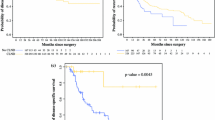Abstract
Background: Elective lymph node dissection ELND may contribute to a survival benefit in certain stratified subsets of melanoma patients. We hypothesized that lymphatic mapping and sentinel lymph node SLN biopsy with complete node dissection if metastases are present may improve both staging and survival of patients with clinically negative nodes, without subjecting all patients to the morbidity associated with complete ELND.
Methods: We reviewed the data for all 14,914 N0 patients of the AJCC Melanoma Staging Database to determine the effect of SLN biopsy and ELND on staging and survival.
Results: Retrospective analysis revealed that there was an apparent statistically significant survival advantage to SLN biopsy in patients with melanomas >1 mm n = 9024; 68.5% and 26.2% reduction in mortality compared with patients staged to be N0 by clinical exam and ELND, respectively; P < .0001. Five-year survivals were 90.5%, 77.7%, and 69.8%, respectfully, for patients staged by SLN biopsy n = 2552, ELND n = 2014, and clinical examination alone n = 5192. The survival advantage of SLN biopsy was statistically significant for each T-stage category T2, T3, and T4 and ulceration status. There was no advantage to SLN biopsy in patients with melanomas <1 mm n = 5890.
Conclusions: SLN biopsy provides more accurate staging and may contribute to a survival benefit in populations of patients with melanoma.
Similar content being viewed by others
References
Roses DF, Provet JA, Harris MN, Gumport SL, Dubin N. Prognosis of patients with pathologic stage II cutaneous malignant melanoma. Ann Surg 1985; 201: 103–7.
Callery C, Cochran AJ, Roe DJ, et al. Factors prognostic for survival in patients with malignant melanoma spread to the regional lymph nodes. Ann Surg 1982; 196: 69–75.
Milton GW, Shaw HM, McCarthy WH, Pearson L, Balch CM, Soong SJ. Prophylactic lymph node dissection in clinical stage I cutaneous malignant melanoma: results of surgical treatment in 1319 patients. Br J Surg 1982; 69: 108–11.
Balch CM, Soong SJ, Murad TM, Ingalls AL, Maddox WA. A multifactorial analysis of melanoma. II. Prognostic factors in patients with stage I (localized) melanoma. Surgery 1979; 86: 343–51.
Balch CM. The role of elective lymph node dissection in melanoma: rationale, results, and controversies. J Clin Oncol 1988; 6: 163–72.
Veronesi U, Adamus J, Bandiera DC, et al. Inefficacy of immediate node dissection in stage 1 melanoma of the limbs. N Engl J Med 1977; 297: 627–30.
Veronesi U, Adamus J, Bandiera DC, et al. Delayed regional lymph node dissection in stage I melanoma of the skin of the lower extremities. Cancer 1982; 49: 2420–30.
Sim FH, Taylor WF, Ivins JC, Pritchard DJ, Soule EH. A prospective randomized study of the efficacy of routine elective lymphadenectomy in management of malignant melanoma. Preliminary results. Cancer 1978; 41: 948–56.
Sim FH, Taylor WF, Pritchard DJ, Soule EH. Lymphadenectomy in the management of stage I malignant melanoma: a prospective randomized study. Mayo Clin Proc 1986; 61: 697–705.
Balch CM, Soong SJ, Bartolucci AA, et al. Efficacy of an elective regional lymph node dissection of 1 to 4 mm thick melanomas for patients 60 years of age and younger. Ann Surg 1996; 224: 255–63.
Balch CM, Soong S, Ross MI, et al. Long-term results of a multi-institutional randomized trial comparing prognostic factors and surgical results for intermediate thickness melanomas (1.0 to 4.0 mm). Intergroup Melanoma Surgical Trial. Ann Surg Oncol 2000; 7: 87–97.
Reintgen DS. Emerging evidence for a survival benefit associated with regional lymph node dissection for melanoma. Ann Surg Oncol 2000; 7: 75–6.
Cabanas RM. Anatomy and biopsy of sentinel lymph nodes. Urol Clin North Am 1992; 19: 267–76.
Morton DL, Wen DR, Wong JH, et al. Technical details of intraoperative lymphatic mapping for early stage melanoma. Arch Surg 1992; 127: 392–9.
Lingam MK, MacKie RM, McKay AJ. Intraoperative identification of sentinel lymph node in patients with malignant melanoma. Br J Cancer 1997; 75: 1505–8.
Reintgen D, Rapaport D, Tanabe KK, Ross M. Lymphatic mapping and sentinel node biopsy in patients with malignant melanoma. J Fla Med Assoc 1997; 84: 188–93.
Messina JL, Glass LF. Pathologic examination of the sentinel lymph node. J Fla Med Assoc 1997; 84: 153–6.
Joseph E, Messina J, Glass FL, et al. Radioguided surgery for the ultrastaging of the patient with melanoma. Cancer J Sci Am 1997; 3: 341–5.
Morton DL, Thompson JF, Essner R, et al. Validation of the accuracy of intraoperative lymphatic mapping and sentinel lymphadenectomy for early-stage melanoma: a multicenter trial. Multicenter Selective Lymphadenectomy Trial Group. Ann Surg 1999; 230: 453–63.
Cascinelli N, Morabito A, Santinami M, MacKie RM, Belli F. Immediate or delayed dissection of regional nodes in patients with melanoma of the trunk: a randomised trial. WHO Melanoma Programme. Lancet 1998; 351: 793–6.
Norman J, Cruse CW, Espinosa C, Cox C, Berman C, Clark R, Saba H, Wells K, Reintgen D. Redefinition of cutaneous lymphatic drainage with the use of lymphoscintigraphy for malignant melanoma. Am J Surg 1991; 162: 432–7.
Kirkwood JM, Strawderman MH, Ernstoff MS, Smith TJ, Borden EC, Blum RH. Interferon alfa-2b adjuvant therapy of high-risk resected cutaneous melanoma: the Eastern Cooperative Oncology Group Trial EST 1684. J Clin Oncol 1996; 14: 7–17.
Author information
Authors and Affiliations
Corresponding authors
Additional information
*Members of the AJCC Melanoma Staging Committee: Charles M. Balch, MD, Antonio C. Buzaid, MD, Seng-Jaw Soong, PhD, Michael B. Atkins, MD, Natale Cascinelli, MD, Daniel G. Coit, MD, Irvin D. Fleming, MD, Jeffrey E. Gershenwald, MD, Alan Houghton Jr., MD, John M. Kirkwood, MD, Kelly M. McMasters, MD, Martin F. Mihm, MD, Donald L. Morton, MD, Douglas S. Reintgen, MD, Merrick I. Ross, MD, Arthur Sober, MD, John A. Thompson, MD, and John F. Thompson, MD.
Rights and permissions
About this article
Cite this article
Dessureault, S., Soong, SJ., Ross, M.I. et al. Improved Staging of Node-Negative Patients With Intermediate to Thick Melanomas (>1 mm) With the Use of Lymphatic Mapping and Sentinel Lymph Node Biopsy. Ann Surg Oncol 8, 766–770 (2001). https://doi.org/10.1007/s10434-001-0766-1
Received:
Accepted:
Issue Date:
DOI: https://doi.org/10.1007/s10434-001-0766-1




